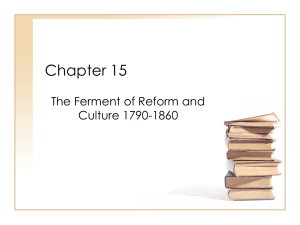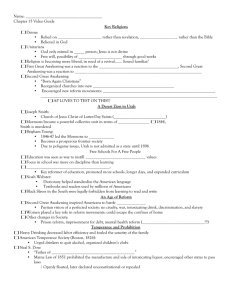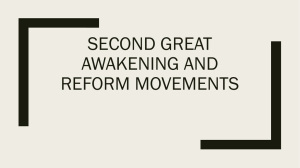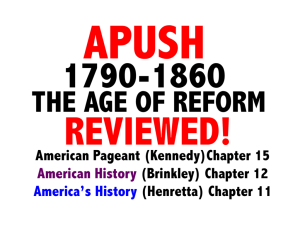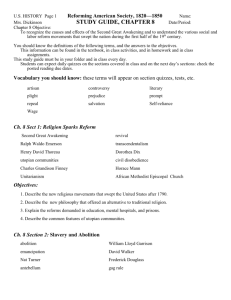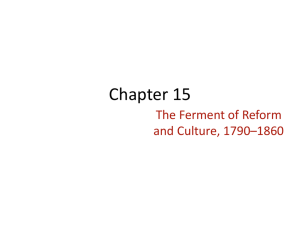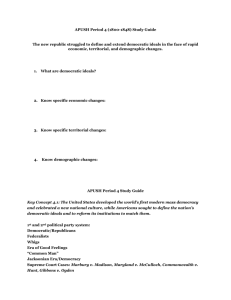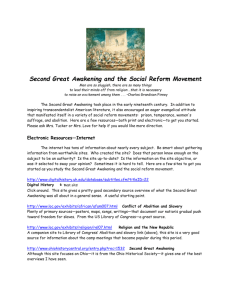ReformersAntebellum - New Smyrna Beach High School
advertisement
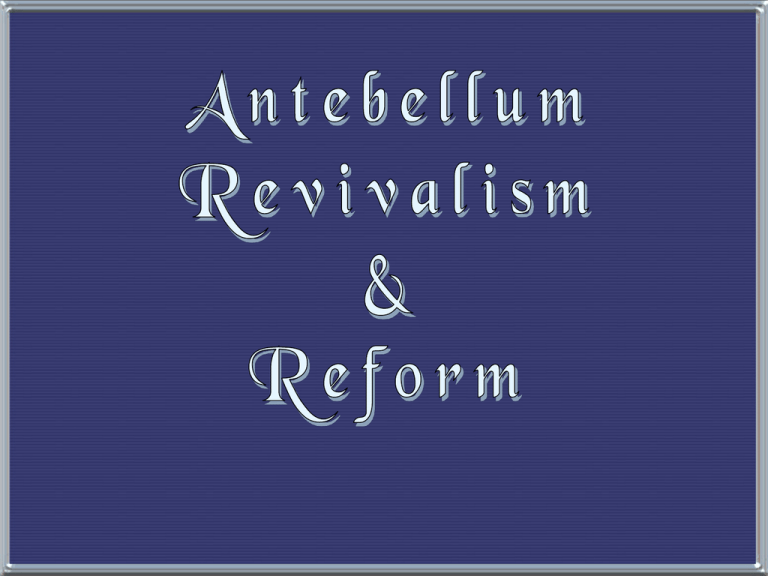
1. The Second Great Awakening “Spiritual Reform From Within” [Religious Revivalism] Social Reforms & Redefining the Ideal of Equality Temperance Education Abolitionism Asylum & Penal Reform Women’s Rights The Rise of Popular Religion In France, I had almost always seen the spirit of religion and the spirit of freedom pursuing courses diametrically opposed to each other; but in America, I found that they were intimately united, and that they reigned in common over the same country… Religion was the foremost of the political institutions of the United States. -- Alexis de Tocqueville, 1832 R1-1 • Christians learned that they could conquer sin. The drunkard could stop drinking. The adulterer could become faithful. The slaveholder could free his slaves. The Christian could stop using the name of the Lord in vain, could observe the Sabbath, could be truthful, could, in short, obey God's commandments. This notion of conquest provided an enormous energy to the converted. They could remake themselves. And, since society was simply a collection of individuals, they could remake it as well. Evangelicals were reformers by definition. “The Pursuit of Perfection” In Antebellum America Second Great Awakening Revival Meeting Revival Preaching Open-Air Revivals Mission to the Slaves Pro-Slavery Reform ”The dissemination of moral truth will always be found at once the cheapest & most effective support of law & order, the most certain check of incendiarism & turbulence." - Basil Manly The Rise of African American Churches • Revivalism also spread to the African American community • The Second Great Awakening has been called the "central and defining event in the development of AfroChristianity“ • During these revivals Baptists and Methodists converted large numbers of blacks Afro-Christianity • Richard Allen founded Bethel African Methodist Episcopal Church (A.M.E.) after whites tried to segregate St. George’s Methodist Church in Philadelphia Richard Allen Mother Bethel AME Church Floating churches to minister to seamen 2nd Great Awakening -Early 1800’s, 1790 to 1840 -Reject Calvinism; accepted Salvation open to all, spiritual equality, Free Will -Timothy Dwight, Charles G. Finney, & Peter Cartwright -Revivalism, emotional Evangelical Christianity -Impact: Mass participation led to mass democracy? Women active participants, equal value of their souls The “Burned-Over” District in Upstate New York Perfectionism • Prophecies of the millennium – Revelations – Latter days of Earth, 1000 years of peace where saints would rule and evil would be banished from the world • Might begin in the US, needed to convert and perfect the nation • “Overturn and overturn till He whose right it is shall come and reign, King of nations and King of Saints” –Lyman Beecher • Drive behind Benevolent Associations, reforms • “If the church would do her duty, the millennium may come in this country in three years.” –Charles Finney • “Christians should aim at being holy and not rest satisfied until they are as perfect as God.” –Charles Finney Charles G. Finney The ranges of tents, the fires, (1792 – 1895) reflecting light…; the candles and lamps illuminating the encampment; hundreds moving to and fro…;the preaching, praying, singing, and shouting,… like the sound of many waters, was enough to swallow up all the powers of contemplation. Conversion Experience New form of revival “soul-shaking” conversion R1-2 •Meeting night after night to build excitement •Praying for sinners by name •Encouraging women to testify in public •Placing those struggling with conversion on the “anxious bench” at the front of the church Baptist and Methodist become the largest denominations in the country Religious Divisions The Mormons (The Church of Jesus Christ of Latter-Day Saints) Joseph Smith e 1823 --> Golden Tablets e 1830 --> Book of Mormon eReaction to elevated status of females as the virtuous sex Hill Cumorah, Palmyra, NY The Mormon “Trek” Reconstructed Temple Nauvoo, Illinois The Mormons (The Church of Jesus Christ of Latter-Day Saints) Brigham Young Mormon Temple Salt Lake City, Utah e Deseret community. e Salt Lake City, UT Mother Ann Lee The Shakers e Mother Ann Lee Stanley claimed to be 2nd, female incarnation of Jesus Christ e Men and women separate, forbid sex & marriage e Stressed simplicity, Examples: e If you will take up your crosses against the works of generations, and follow Christ in the regeneration, God will cleanse you from all unrighteousness. e Remember the cries of those who are in need and trouble, that when you are in trouble, God may hear your cries. e If you improve in one talent, God will give you more. R1-4 Shaker Meeting Shaker Hymn 'Tis the gift to be simple, 'Tis the gift to be free, 'Tis the gift to come down where you ought to be, And when we find ourselves in the place just right, 'Twill be in the valley of love and delight. When true simplicity is gained To bow and to bend we shan't be ashamed, To turn, turn will be our delight, 'Till by turning, turning we come round right. Round Barn (1826) Hancock Shaker Village Shaker Simplicity & Utility William Miller- Millerism • Predicted Christ would come again on October 22, 1843 • Important ideamany reformers motivated by the belief that if they perfected society (perfectionism), it would bring the second coming of Jesus Antebellum Reform Movements • Humanitarian Reforms or Social Control “Hidden Curriculum” in school • • • • • • • • Confusion Class Position Indifference Emotional Dependency Intellectual Dependency Provisional Self-Esteem One cannot hide How are schools like factories? How do you get in trouble in school? Impact of Industrialization • Destroyed artisan class • Segregation of work from life – Preindustrial workshops • Masters and workers “like a family” • Work and living space the same • Social lives integrated – Industrial system • Masters absent, workers in boarding houses • Neighborhoods segregated, rich and poor • Socializing segregated: classbased values, conflict surrounding forms of leisure (esp. drinking) Impact of Industrialization • Undermined patriarchal family – Children earning own wages, more independent – Altered outlook and lives of women • Time and work discipline – Adjusting to industrial rhythms – Led to further calls for reform • Religious ferment, social reform, utopian experimentation I. Temperance Movement 1826 - American Temperance Society “Demon Rum”! Frances Willard The Beecher Family Frederick Marryat, an English captain who noted in 1839: • The Americans can fix nothing, without a drink. If you meet, you drink; if you part, you drink; if you make acquaintance, you drink; if you close a bargain, you drink; they quarrel in their drink, and they make it up with a drink. They drink, because it is hot; they drink because it is cold. If successful in elections, they drink and rejoice; if not, they drink and swear; they begin to drink early in the morning, they leave off late at night; they commence it early in life, and they continue it, until they soon drop into the grave. • Had Marryat accepted every drink he was offered, he complained, he would have not been “sober for three or four weeks at a time.” Teetotal abstinence vs. temperance (stay off the hard stuff) • Sin on the order of slavery, if not greater • Grog time twice a day when a bell rang, shift to coffee • Average person drank 88 gallons of whiskey a year • US spent more each year on alcohol than the total of the federal government’s expenditure • Washingtonian Societies, ½ million would join Annual Consumption of Alcohol -Most successful reform movement -By 1857 12 states had prohibition laws, many soon repealed -Maine Law- Neal Dow -Ten Nights in a Barroom and What I Saw There. (1854), T.S. Arthur, 2nd best selling book -Church led, Lyman Beecher -Directed against Irish & German immigrants The Drunkard’s Progress: From the first glass to the grave, 1846 "Step 1. A glass with a friend. Step 2. A glass to keep the cold out. Step 3. A glass too much. Step 4. Drunk and riotous. Step 5. The summit attained...Jolly companions...A confirmed drunkard. Step 6. Poverty and disease. Step 7. Forsaken by Friends. Step 8. Desperation and Crime. Step 9. Death by suicide." II.Penitentiary Reform • Shift from punishment to rehabilitate, stressed religion • No longer jail for debtors 1821 first penitentiary founded in Auburn, NY Dorothea Dix •pioneer in the movement to treat the insane as mentally ill rather than as criminals •15 states set aside land and created new hospitals & asylums as a result III. Gradualists Abolitionist Movement Immediatists Anti-Slavery Alphabet e 1816 American Colonization Society created (gradual, voluntary emancipation.) eShip slaves back to Africa, created a free slave state in Liberia, West Africa. e6,000 immigrants, 1817-67 British Colonization Society symbol William Lloyd Garrison (1801-1879) e Founded American Antislavery Society (AAS), 1831 e Immediate emancipation with NO compensation. e Slavery was a moral, not an economic issue. It was a sin against God. e Baptist Church divided into a N & S The Liberator Premiere issue January 1, 1831 The Liberator #1 by William Lloyd Garrison Article in the first issue of Garrison's newspaper The Liberator January 1, 1831 • “I am aware that many object to the severity of my language; but is there not cause for severity? I will be as harsh as truth, and as uncompromising as justice. On this subject, I do not wish to think, or speak, or write, with moderation. No! no! Tell a man whose house is on fire to give a moderate alarm; tell him to moderately rescue his wife from the hands of the ravisher; tell the mother to gradually extricate her babe from the fire into which it has fallen; -- but urge me not to use moderation in a cause like the present. I am in earnest -- I will not equivocate -- I will not excuse -- I will not retreat a single inch -- and I will be heard. The apathy of the people is enough to make every statue leap from its pedestal, and to hasten the resurrection of the dead.” The Tree of Slavery—Loaded with the Sum of All Villanies! James Birney e Slavery in politics, Liberty Party. e ran Birney for President in 1840 & 1844. e Little success, absorbed by Free Soil Party Black Abolitionists David Walker 1829 --> Appeal to the Coloured Citizens of the World Fight for freedom rather than wait to be set free by whites. Frederick Douglass (1817-1895) 1845 The Narrative of the Life Of Frederick Douglass 1847 “The North Star” R212 Sojourner Truth or Isabella Baumfree 1850 --> The Narrative of Sojourner Truth Harriet Tubman “Moses” e Helped over 300 slaves to freedom. e $40,000 bounty on her head. e Served as a Union spy during the Civil War. The Underground Railroad The Underground Railroad e “Conductor” ==== leader of the escape e “Passengers” ==== escaping slaves e “Tracks” ==== routes e “Trains” ==== farm wagons transporting the escaping slaves e “Depots” ==== safe houses to rest/sleep “The Gag Rule” • Abolitionists in 1831 submitted petitions for the abolition of slavery to Congress • Anti-slavery petitions were gagged from 1835 to 1844 & ended with the help of John Quincy Adams IV. Transcendentalism e “Transcend” the limits of intellect and allow the emotions, the SOUL, to create an original relationship with the Universe. e Stressed individualism e Reaction to Market Revolution, yearn to be in touch with nature Writers Concord, MA Ralph Waldo Emerson Nature (1832) Self-Reliance (1841) “The American Scholar” (1837) Henry David Thoreau Walden (1854) Resistance to Civil Disobedience (1849) Read pages 25 26 V.Utopian Communities If social arrangements could be perfected, then the ills of society could be eliminated. The Oneida Community New York, 1848 e Humans were no longer obliged to follow the moral rules of the past, 2nd coming had happened. • all residents married to each other, • complex marriage. • communal child rearing John Humphrey Noyes • Economically successful b/c of plates and silverware George Ripley Brook Farm West Roxbury, MA, 20 intellectuals lived there, practiced socialism Robert Owen Utopian Socialist “Village of Cooperation” Original Plans for New Harmony, IN New Harmony in 1832 New Harmony, IN VI. e MA Educational Reform always on the forefront of public educational reform * 1st state to establish tax support for local public schools. 1860 every Northern (fix) state offered free public education to whites. * US had one of the highest literacy rates. e By Horace Mann “Father of American Education” children were clay in the hands of teachers and school officials children should be “molded” into a state of perfection discouraged corporal punishment established state teachertraining programs (Normal Schools) The McGuffey Readers e Used religious parables to teach “American values.” e Teach middle class morality and respect for order. e Teach “3 Rs” + “Protestant ethic” (frugality, hard work, sobriety) Noah Webster • Dictionary, standardized American spelling • Example, color vs. colour VII. Sectionalism • Reforms more of a Northern and Western phenomenon • Northerners modernizing, while Southerners committed to tradition To what extent and in what ways did the roles of women change in American society between 1780 to 1860? Respond with reference to TWO of the following areas: Domestic Economic Political Social 8. “Separate Spheres” Concept “Cult of Domesticity” e A woman’s “sphere” was in the home (it was a refuge from the cruel world outside). e Market Revolution separated the two worlds e Her role was to “civilize” her husband and family. e Suppose to uphold the qualities of piety, purity, domesticity, and submissiveness e Mainly applied to Middle and Upper class women An 1830s MA minister: The power of woman is her dependence. A woman who gives up that dependence on man to become a reformer yields the power God has given her for her protection, and her character becomes unnatural! Early th 19 Century Women 1. Unable to vote. 2. Legal status of a minor. 3. Single could own her own property. 4. Married no control over her property or her children. 5. Could not initiate divorce. 6. Couldn’t make wills, sign a contract, or bring suit in court without her husband’s permission. Cult of Domesticity = Slavery The 2nd Great Awakening inspired women to improve society. Angelina Grimké Sarah Grimké e Southern Abolitionists Lucy Stone e American Women’s Suffrage Assoc. e edited Woman’s Journal Dress: Bloomers vs. Petticoats What It Would Be Like If Ladies Had Their Own Way! Women’s Rights 1840 --> split (Schism of 1840) in the abolitionist movement (AAS) over women’s role in it. London --> World Anti-Slavery Convention Lucretia Mott 1848 -->Seneca Elizabeth Cady Stanton Falls, Declaration of Sentiments & birth of Women’s Rights movement Read the second pages 27-32 • Some historians have argued that the elections of 1800 and 1828 were revolutions in American political history. • Support, modify, or refute this contention using specific evidence. • • • Some historians have characterized the period from 1824 to 1848 as the era of the common man. Support, modify, or refute this contention using specific evidence. • • Some historians have argued that the forces that opposed the growth of the federal government’s power (state’s rights advocates) were stronger in the early republic than those that promoted a strong central government (Nationalist) from 1789 to 1848. • Support, modify, or refute this contention using specific evidence. • • Some historians have argued that the economy that emerged after the War of 1812 constituted an industrial revolution. Support, modify, or refute this contention using specific evidence. • Some historians have argued that the antebellum reform movements in the United States from 1815 to 1860 sought to expand democratic ideals. • Support, modify, or refute this contention using specific evidence. To what extent and in what ways did the roles of women change in American society between 1783 to 1860? Respond with reference to TWO of the following areas: Domestic Economic Political Social Domestic • Republican Motherhood to Cult of Domesticity Economic • Go from economic partners in production as part of the household economic unit, putting out method for factory work, barter economy to • Market Revolution- women’s work was marginalized, separation of work and home Political • Goes from no rights to the start of a political protest, Seneca Falls Social • Not supposed to play much of a role outside the home to a role in reform movements, abolition, temperance, religion, women’s rights, asylum movement “Reform movements in the US from 1820 – 1860 sought to expand democratic ideals” -Assess the validity of this statement • 6 points- Answer the following essay prompt using the method below. DO NOT NECESSARILY USE POLITICAL, ECONOMIC, AND SOCIAL AS YOUR CATEGORIES!!! THIS WILL NOT WORK FOR ALL QUESTIONS, MANY ARE MORE NARROWED IN SCOPE THAN THIS. • • • • • • • • • • • • • • • • • • • 1. 2. Example: Identify 3 main points with analysis List 3 concrete facts to support each of your 3 main points How revolutionary was the American Revolution? Politically, the war established America’s independence from England. Declaration of Independence-John Locke, Natural Rights Saratoga- French alliance Constitution- Beard Thesis Socially, the war saw significant gains in the rights of blacks in the North and the status of women in the domestic sphere. Northwest Ordinance, abolished slavery in NW territory Abigail Adams quote Republican Motherhood, less strict divorce laws Economically, the war broke the mercantilist hold on American colonies and allowed the country to build its own economy in an unstable fashion. Depression after the war, “ain;t worth a continental" Shay’s Rebellion Freedom of the Seas- Napoleonic Wars “Reform movements in the US from 1820 – 1860 sought to expand democratic ideals” -Assess the validity of this statement 3/6 points • Women – Seneca Falls – Stanton & Mott – Declaration of Sentiments • Abolition – AAS – The Liberator – William Lloyd Garrison • Temperance – Maine Law – Neal Dow – Ten Nights in a Barroom and What I Saw There Why 3/6? No analysis “Reform movements in the US from 1820 – 1860 sought to expand democratic ideals” -Assess the validity of this statement • Women: democratic ideals or not? • Abolition: democratic ideals or not? • Temperance: democratic ideals or not? “Reform movements in the US from 1820 – 1860 sought to expand democratic ideals” -Assess the validity of this statement • The Women’s rights movement promoted democratic ideals in America. How? • The Abolition movement promoted democratic ideals in America. How? • The Temperance movement promoted democratic ideals in America. How? “Reform movements in the US from 1820 – 1860 sought to expand democratic ideals” -Assess the validity of this statement • The Women’s rights movement promoted democratic ideals in America by encouraging equal rights between the sexes. • The Abolition movement promoted democratic ideals in America by trying to free a race of enslaved people. • The Temperance movement promoted democratic ideals in America by encouraging and enforcing the majority’s moral ideals on the nation. Perfect 6/6 Points • The Women’s rights movement promoted democratic ideals in America by encouraging equal rights between the sexes. – Seneca Falls – Stanton & Mott – Declaration of Sentiments • The Abolition movement promoted democratic ideals in America by trying to free a race of enslaved people. – AAS – The Liberator – William Lloyd Garrison • The Temperance movement promoted democratic ideals in America by encouraging and enforcing the majority’s moral ideals on the nation. – Maine Law – Neal Dow – Ten Nights in a Barroom and What I Saw There Big Ideas to Understand: 1. How democratic were the politics and reforms of the age? 2. How and why did political parties reappear and grow during this age? 3. Were reforms motivated by humanitarian ideals of for social control purposes? 4. How did the power of the federal government grow in comparison to state power? Jacksonian Democracy From 2001 • The Jacksonian Period (1824-1848) has been celebrated as the era of the “common man.” To what extent did the period live up to its characterization? Consider TWO of the following in your response – Economic development – Politics – Reform movements From 1999 • How did TWO of the following contribute to the reemergence of a two party system in the period 1820 to 1840? – Major political personalities – States rights – Economic issues • “Andrew Jackson’s election as President marked the beginning of a new age in political history.” – Assess the validity of this statement • Analyze the presidential policies of Andrew Jackson in relation to the power of the federal government compared to states rights. • Compare and contrast the goals and philosophies of the Democrats and Whigs from 1824 to 1854 From 1996 • Analyze the extent to which TWO of the following influenced the development of democracy between 1820 and 1840. – Jacksonian economic policy – Changes in electoral politics – Second Great Awakening Reforms • Assess the extent to which economic changes in American society encouraged TWO of the following reform movements – Public education – Temperance – Women’s Rights – Utopian Communities From 1988 • “American reform movements between 1820 and 1860 reflected both optimistic and pessimistic views of human nature and society.” • Assess the validity of this statement in reference to reform movements in THREE of the following areas. – – – – – Education Temperance Woman’s rights Utopian experiments Penal institutions From 1993 • In what ways did the early nineteenthcentury reform movements for abolition and women’s rights illustrate both the strengths and the weaknesses of democracy in the early American republic? From 1985 • “Most major religious movements reflect significant shifts in religious beliefs and produce important social changes.” • -Assess the validity of this statement in relation to The Second Great Awakening from 1790 to 1860 From 1994 • Analyze the ways in which The Second Great Awakening during the 19th Century influenced the development of American society. • Analyze the extent to which the Second Great Awakening transformed American religion in the years from 1790 to 1860. • Discuss the changing ideals of American womanhood between the American Revolution and the outbreak of the Civil War. • What factors caused the emergence of “republican motherhood” and the “cult of domesticity?” • Assess the extent to which these ideals influenced the lives of women during this period. Tecumseh • Some Historians have described the administration of Andrew Jackson as the “Reign of King Andrew” and others as the “Champion of the Common Man.” • Which label is a more accurate description of Andrew Jackson’s Presidency? • In what ways did the 2nd Great Awakening influence TWO of the following? –Abolitionism –Temperance –The cult domesticity –Utopian communities • How democratic was the “Age of Jackson” in the US from 1800-1848? – Please consider TWO of the following in your response • Religion • Political voting & election law developments • Andrew Jackson’s presidency • How democratic was the “Age of Jackson” in the US from 1800-1848? • Political voting & election law developments –Universal white male suffrage by states –People vote on the Presidential Electors –Nominating Conventions –Spoils System –Campaigns, Election 1840, Log Cabin –No for women, AA, and Indians –Political parties: Whigs + Dems • How democratic was the “Age of Jackson” in the US from 1800-1848? – Please consider TWO of the following in your response • Andrew Jackson’s presidency –Nullification –Bank –Native American removal –Spoils System –Use of Vetoes How democratic was the “Age of Jackson” in the US from 1800-1848? • Religion – 2nd Great Awakening – Free Will- individual choice for salvation, moral free agent – Preached and converted women and African Americans – Charles Finney – Burned over district – Growth of denominations: Methodists and Baptists – Splinter Groups; Shakers, Mormons, William Miller – Perfectionism – Reforms: Temperance & Abolition Religion and Reform in Antebellum America I. Second Great Awakening A. Spreading the Word 1. Charles Grandison Finney 2. Revivals 3. Methodist and Baptists predominate 4. Burned Over district B. Building a Christian Nation 1. Established churches. 2. Itinerant preachers. 3. Start small. 4. Lots of splinter sects C. Interpreting the Message 1. Working to bring God's vision in the world 2. Change starts in the churches II. Northern Reform A. The Rising Power of American Abolition B. Women's Rights and Utopian Communities C. The Temperance Crusade III. Southern Reform A. Sin, salvation, and honor B. Pro-Slavery Reform C. Nat Turner and Afro-Christianity D. Southern anti-slavery reformers Second Great Awakening Charles Grandison finney "I have a retainer from the Lord Jesus Christ to plead his cause, I cannot plead yours." Open-Air Revivals Building a Christian Nation -Nathan Bangs Methodist Minister Splinter Groups Shakers Mormons Ann Lee Joseph Smith Brigham Young Interpreting the Message Pennsylvania Abolition Society PAS Manumission Papers Frederick Douglass William Lloyd Garrison Sarah and Angelina Grimke Angelina Grimke : "Whatever it is morally right for man to do … it is morally right for women to do." "I believe it is women's right to have a voice in all the laws and regulations by which she is to be governed, whether in Church or State.” ”Just as much right to sit upon the throne of England, or in the Presidential chair of the United States." Angelina Grimke Seneca Falls Elizabeth Cady Stanton Temperance American Temperance Society (1826) Henry Ward Beecher Southern Reform Mission to the Slaves ”The dissemination of moral truth will always be found at once the cheapest & most effective support of law & order, the most certain check of incendiarism & turbulence." - Basil Manly Nat Turner David Walker "Americans may be as vigilant as they please, but they cannot be vigilant enough for the Lord, neither can they hide themselves, where he will not find and bring them out." -David Walker (1829) The Drunkard’s Progress: From the first glass to the grave, 1846 "Step 1. A glass with a friend. Step 2. A glass to keep the cold out. Step 3. A glass too much. Step 4. Drunk and riotous. Step 5. The summit attained...Jolly companions...A confirmed drunkard. Step 6. Poverty and disease. Step 7. Forsaken by Friends. Step 8. Desperation and Crime. Step 9. Death by suicide." Threats to Protestantism • Elites abandoned orthodox Christianity – Most Founding Fathers were Enlightenment Deists • Believed in creator God • Rejected divinity of Jesus & miracles • Believed man’s reason could figure everything out – Unitarians split Congregational establishment in New England • Took control of Harvard & wealthiest urban churches • Est. American Unitarian Association in 1826 • Catholic & Lutheran immigrants practiced different forms of Christianity • Transcendentalism emphasized individualism & emotion/intuition over reason – Ralph Waldo Emerson – Henry David Thoreau (Walden, Civil Disobedience) Colonial Protestant Establishment Unable to Meet Changing Conditions • Insistence on educated clergy worked against needs of the frontier communities – Clergy tended to have middle-class disdain for uncouth frontier life – Calvinist theology too complex & restrictive for uneducated poor people • Disestablishment & 1st Amendment created competition among denominations • Only by using non-seminary-trained ministers could demand be supplied – 1775: 1,800 ministers (1:1,500) – 1845: 40,000 ministers (1:500) – Revivalists used democratic rhetoric to attack “aristocratic” religious elites Second Great Awakening: Methodists • Methodism came over to America after successfully transforming Great Britain in the late 1700s – John & Charles Wesley began reform movement within the Anglican Church – later became Methodist Episcopal Church – Francis Asbury was 1st Methodist Bishop in the U.S. – Peter Cartwright was leading circuit rider – preached salvation as a free gift to all – Set up Sunday Schools & Bible studies John Wesley Francis Asbury The Spread of Methodism Methodist Camp Meeting Second Great Awakening: Baptists • Baptists also spread rapidly – Rejected Calvinist roots – John Leland combined Jeffersonian democracy with Christian morality • Both groups used popular mass culture – Took advantage of cheap printing to produce Bibles, tracts, Sunday School curricula, etc. – Took popular songs and wrote new lyrics • Created interdenominational organizations: – American Bible Society – American Sunday School Union – American Tract Society Leland Cheese Monument Cheshire, Mass. Afro-Christianity • Richard Allen founded Bethel African Methodist Episcopal Church (A.M.E.) after whites tried to segregate St. George’s Methodist Church in Philadelphia Richard Allen Mother Bethel AME Church Revival Preaching Quiz- Chapter 12 1. What type of work did Lyman Beecher and Charles Grandison Finney do? 2. What was Dorthea Dix famous for? 3. Please name one utopian community & briefly explain what people did there. 4. Please name one romantic writer and briefly explain the main idea of their writings. 5. What was the ideal of domesticity? 6. Please briefly explain one division in the abolitionist movement. Essay Topics • Some historians have argued that the elections of 1800 and 1828 were revolutions in American political history. • Support, modify, or refute this contention using specific evidence. • Some historians have characterized the period from 1824 to 1848 as the era of the common man. • Support, modify, or refute this contention using specific evidence. • Some historians have argued that the forces that opposed the growth of the federal government’s power were stronger in the early republic than those that promoted it from 1789 to 1848. • Support, modify, or refute this contention using specific evidence. • • • • • • • Background: AoC v. Constitution, confederation vs. federalism Bank – Hamilton v. Jefferson, Jefferson’s party re-chartered- American System, McCulloch v. Maryland, Implied Powers, centralization of powers, Jackson veto gave power to the states Taxes – Excise tax & Whiskey Rebellion, Increased federal power – Jefferson cuts taxes and spending to decrease federal power – Nullification Crisis- Jackson, Calhoun, increased federal power Marshall Court – Judicial Review, Marbury v Madison instead of the state idea of the Virginia and Kentucky Resolutions nullification – McCulloch- implied powers – Gibbons- commerce clause – Dartmouth, Fletcher, right of contract – Increase federal power Hartford Convention – Embargo Act 1807, War of 1812, Mr. Madison’s War, state’s rights New England, secession, failed, Political Parties – Hamilton v Jefferson (Federalist v. Democratic Republican), Jackson v. Clay (Democrats v. Whigs) Future: Civil War fought over the issue • Some historians have argued that the antebellum reform movements in the United States from 1815 to 1860 sought to expand democratic ideals. • Support, modify, or refute this contention using specific evidence. • • • • • • • • Background: 1st Great Awakening Second Great Awakening Temperance Abolition Education Utopian Communities Prison Reform Future: Divisions, Whigs v. Democrats, N v. S, See in Progressive Era • Some historians have argued that the economy that emerged after the War of 1812 constituted an industrial revolution. • Support, modify, or refute this contention using specific evidence. Is it an industrial revolution? Missing that link a lot • • • • • • • Market Revolution: – Work and home become separate spheres (women), barter to commercial economy, national economy, capitalism, urbanization Manufacturing– Textiles, NE, Slater, Lowell Girls, Immigrants, water power, Interchangeable parts Agriculture – Cotton Gin + slavery-South, West- bread basket grain, John Deere steel plows, mechanical reapers Transportation – Canals, steamboats, clipper ships, paved roads, turnpikes, start of RRs, interconnected economy, 95% drop in shipping costs Communication – Telegraphs, Morse code, Western Union Government – Laissez-faire economics, patents, LLCs, commerce clause, ends monopolies, American System- Henry Clay, protectionist tariffs Banking – Finance, BUS,
